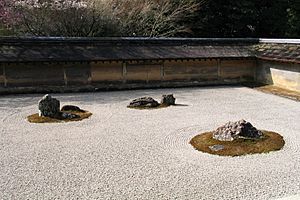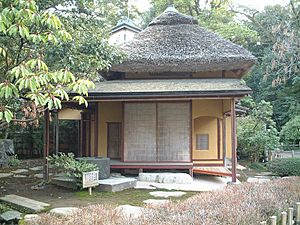Wabi-sabi facts for kids
In traditional Japanese aesthetics, wabi-sabi (侘寂) is a special way of looking at the world. It's all about accepting that things don't last forever and that nothing is perfect. This idea often describes beauty that is "imperfect, temporary, and not finished." You can see wabi-sabi in almost every type of Japanese art.
Wabi-sabi is made up of two ideas: wabi (侘) and sabi (寂). Wabi can mean "quiet, simple beauty," while sabi means "old, rustic look." These ideas come from Buddhism, especially the teachings about how everything changes (impermanence), how life can be difficult (suffering), and how things don't have a fixed nature (emptiness).
The main features of wabi-sabi include things like not being perfectly balanced (asymmetry), having a rough feel, being simple, using only what's needed, being modest, and feeling close to nature. It's about enjoying both natural objects and the power of nature itself.
Contents
Understanding Wabi-Sabi
Many people have tried to explain what wabi-sabi means. Leonard Koren, a designer, said it's "the most noticeable and special part of what we think of as traditional Japanese beauty." He compares it to how the ancient Greeks valued beauty and perfection in the West.
Another way to think about wabi-sabi is that if something makes you feel a calm sadness and a spiritual longing, then it might be wabi-sabi. Richard Powell explains it simply: "Wabi-sabi celebrates everything that is real by accepting three simple truths: nothing lasts, nothing is finished, and nothing is perfect."
The Meanings of Wabi and Sabi
The words wabi and sabi don't have exact English translations. Originally, wabi meant the feeling of being alone in nature, far from people. Sabi meant "cold," "thin," or "withered." But around the 14th century, these meanings started to become more positive.
After many years of being influenced by Chinese art and Buddhist ideas, wabi-sabi became a unique Japanese concept. Over time, the meanings of wabi and sabi became lighter and more hopeful. About 700 years ago, especially among Japanese nobles, understanding imperfection was seen as the first step to satori, or enlightenment.
Today, in Japan, wabi-sabi is often summed up as "wisdom in natural simplicity." In art books, it's usually defined as "flawed beauty." Artworks that show wabi-sabi often highlight the process of how they were made and that they are never truly "finished."
Finding Beauty in Imperfection
Wabi and sabi both suggest feelings of quietness and being alone. In the Buddhist view, these can be good things. They represent freedom from a focus on material things and moving towards a simpler life. However, Buddhist philosophy also says that true understanding can't be found just through words. So, understanding wabi-sabi without words might be the best way.
One way to think of wabi-sabi is like a practice. You learn to find basic, natural objects interesting and beautiful. For example, fading autumn leaves can be seen as beautiful. Wabi-sabi can change how we see the world. A small chip or crack in a vase might make it more interesting and give it deeper meaning. Materials that age, like wood, paper, and fabric, become more interesting as they change over time.
The ideas of wabi and sabi come from religious roots. However, in Japan, people often use these words in everyday conversations because Japanese beliefs often mix different ideas.
Wabi-Sabi in Japanese Arts
Many Japanese art forms have been shaped by Zen and Mahayana Buddhist ideas over the last thousand years. The concepts of accepting imperfection and the constant change of all things are very important to Japanese arts and culture.
Because of this, many art forms show the ideals of wabi-sabi. Here are some examples:
- Honkyoku: This is traditional music played on the shakuhachi (a bamboo flute) by Zen monks.
- Ikebana: The art of arranging flowers.
- Bonsai: Growing miniature trees. A typical bonsai often has rough wood, dead parts, or hollow trunks. These features show the passage of time and nature. Bonsai are often displayed in autumn or winter to admire their bare branches.
- Traditional Japanese gardens: Like Zen gardens, which are often tray gardens.
- Japanese poetry: Especially poems that are simple and evoke feelings of quietness.
- Japanese pottery: Such as Hagi ware, Raku ware, and kintsugi (the art of repairing broken pottery with gold, making the repair part of its beauty).
- Tea ceremony: Especially a style called Wabi-cha, which focuses on simplicity and naturalness.
A famous Japanese essay called In Praise of Shadows by Jun'ichirō Tanizaki also explores the idea of wabi-sabi.
Wabi-Sabi in the Western World
The idea of wabi-sabi has also been used in Western countries in many areas, including art, technology, and media.
Wabi-Sabi and the Arts
Many Western designers, writers, poets, and artists have used wabi-sabi ideas in their work. Some see it as a main part of their art, while others use it in smaller ways.
Designer Leonard Koren wrote a book called Wabi-Sabi for Artists, Designers, Poets & Philosophers (1994). This book looked closely at wabi-sabi and compared it to Western ideas of beauty. His book became very popular among designers.
Wabi-sabi ideas were also very important in the growth of Western studio pottery. Bernard Leach (1887–1979) was greatly influenced by Japanese art and methods, which you can see in his important book A Potter's Book.
The work of American artist John Connell (1940–2009) also focused on wabi-sabi. Other artists, like Jesse Richards (born 1975), use it in almost all their work.
Some haiku in English also use the wabi-sabi style. They create short, simple poems that bring up feelings of quietness and how things change, like Nick Virgilio's poem: "autumn twilight:/ the wreath on the door/ lifts in the wind".
Wabi-Sabi and Technology
In the 1990s, computer software developers started using the idea of wabi-sabi. They used it in agile programming and Wiki to describe how they accepted that computer programs made with these methods would always be a work in progress and not perfect.
Wabi-Sabi in Media
On March 16, 2009, Marcel Theroux presented a show called "In Search of Wabi Sabi" on BBC Four. He traveled around Japan trying to understand the artistic tastes of its people. Theroux started by humorously trying a challenge from the book Living Wabi Sabi by Taro Gold. He asked people on a street in Tokyo to describe wabi-sabi. Just as Gold predicted, they often just gave a polite shrug and said that Wabi-sabi is simply impossible to explain.
See also
 In Spanish: Wabi-sabi para niños
In Spanish: Wabi-sabi para niños




